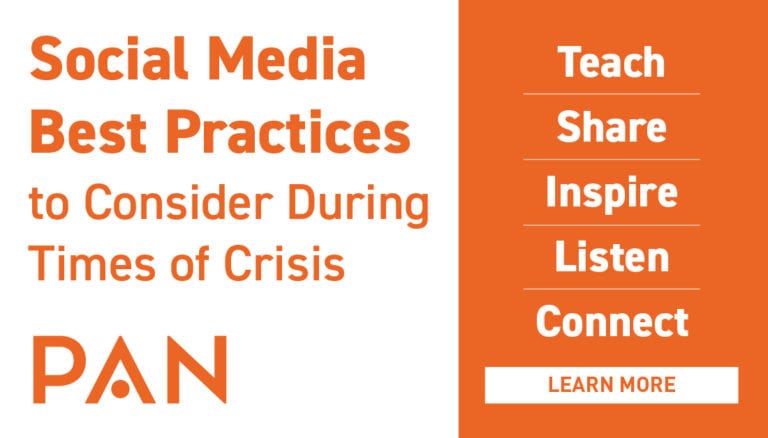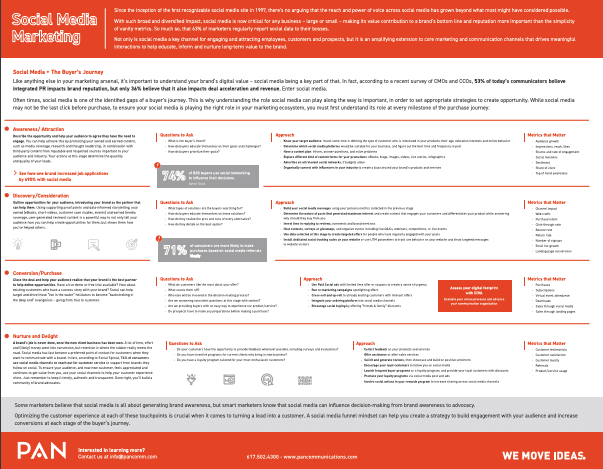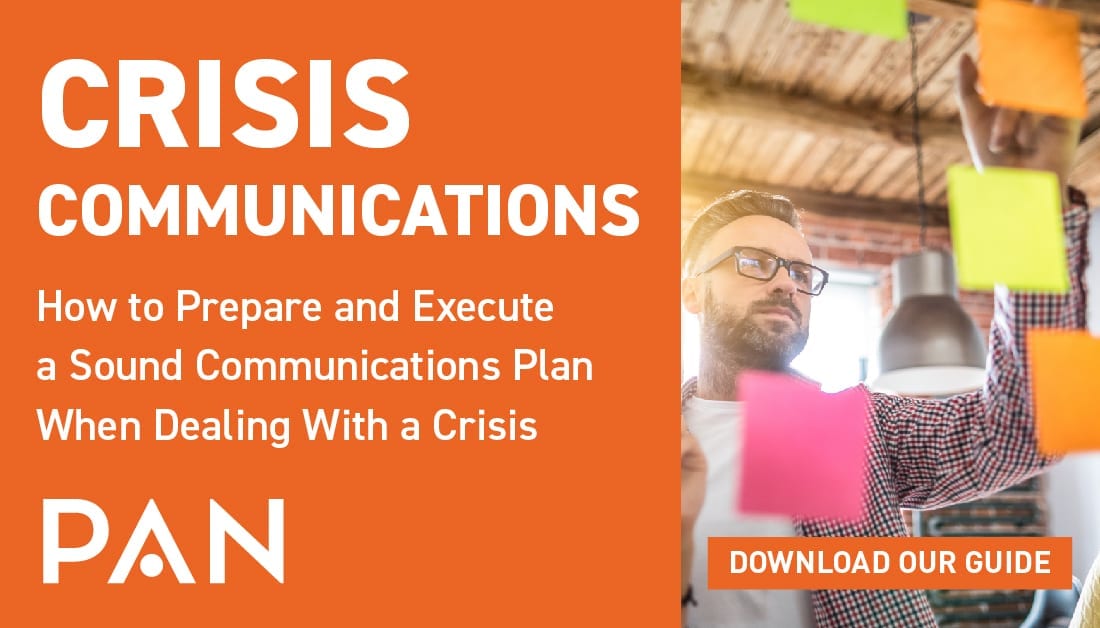Behind every @ symbol following your brand, there’s a person who bestowed a measure of confidence in your company. Followers share their time reading, commenting and liking. That engagement is priceless.
While finding the “right” words during this time may prove difficult, it’s no time for social media distancing. Now’s the time to return the favor. Teach, share, inspire and listen to adjacent, larger conversations. Most of all, connect followers with the information needed to take their best next step.
Marketers should be adjusting their communication strategies across the board – whether it’s media relations, external communications or in this case, social media.
There’s no graceful exit or pause from social media. Silence says too much and others will step in. Consult the guidance below to update your social media framework. Then get out there and share something meaningful.
Click to enlarge the social media framework below as you read through these best practices.
Reconsider Your Tone, Messaging and Intent Across Social Channels
- While social communicators often have broad authority to post and engage online, coordination with the overall enterprise communication plan should take precedence. Stay in sync even if it feels slower than normal.
- Shut off anything auto-scheduled. Content written days or weeks ago will be off-tone.
- Write sample posts and share with communications, brand and marketing colleagues. Solicit feedback and work as a team to ensure content accurately aligns with the overall enterprise communication plan.
- Dedicate a team member to active listening across your ecosystem, including: media, analysts, clients, partners and competitors. Aggregate findings, pair them with a WIM (what it means) analysis, and share the analysis daily. During uncertain times, concrete examples and recommendations serve as a catalyst for discussion whether or not you eventually adopt or dismiss ideas reviewed.
- Take on the hard work of building top-tier relevant content dependent upon clients, partners and internal resources. Provide direction, timelines and samples. Make it easy to participate. Now is a good time to put requests in motion for quotes, comments, data and insights. Hard-to-secure content falls to the bottom of most to-do lists, especially with social. Yet, this content sparks engagement, including shares and comments.
Remain Active (But Cautionary) on Corporate Social Channels
- Social channels connect brands with the larger world and your absence sends the wrong message. If you’ve been committed to building relevant, respectful engagement in your organic social programs, stay the course.
- Suspend paid follower campaigns or at minimum scale back. Overtly commercial messaging may send the wrong message. Focus efforts on existing followers. Social platform recommendation algorithms factor followers, following and content interaction when suggesting companies and individuals to follow. Channels will grow.
- Test paid programs supporting helpful, relevant content and offers. Soften the call to action, dropping the “act now, last day, only 3 left” call to arms. Try the word “free” again. Spam filters may interfere and ad scores may be slightly impacted, but if it’s really no-strings-attached free, then say so.
- Rework content by adapting it to current events. Now is not the time to invest in net-new, long-form content. Share what’s been popular (downloads, views, shares).
- Stay focused on existing content threads, but try new content types. Video content is effective and entertaining. Use your conferencing video capture and strike up a few interviews featuring interesting guests.
- Play it safe. Slow down and write social content like you would a media release. Be careful and concise, and ask for a peer review. The speed in which social content moves plus the volume that can be produced often makes individual tweets less important than the sum of your content. Right now, each post counts.
Retool Your Executive Thought Leadership Strategies
- While it’s natural to hesitate in the face of uncertainty, socially active executives should stay active. Use the words they’ve shared with employees, colleagues and clients as the basis for content development.
- Acknowledge individuals and companies making a difference. See it, like it. Be generous and authentic, especially now.
- Listen and look for opportunities to help. Get creative. Internal employees with a concrete opportunity to help will rally. Present ideas and provide clear go-go-go direction.
Measure and Adjust Your Social Strategy Over Time
- Direct, organic search and paid web traffic easily win on total volume metrics, but social is the “little engine that could.” Typically, social metrics like visitors, sessions, bounce rate, time on site and goal completions best other channels. It’s likely social visitors know or care to learn more about your brand. When in doubt, focus on their needs.
- Content offering support, training and collaboration are on the rise and well received. Webinars are popular, with participation outperforming the norm (on average, 50% of those registered attend). Look to partners and prior sponsors for joint opportunities to author content, promote webinars or present new case studies.
- Set a baseline for social activity before COVID-19 news. In the U.S., consider February 21 – March 27 as the first wave. During this time, events in Italy, trading circuit breaks and halts, unemployment statistics and recession forecasts occurred. Create a simple dashboard tracking social and organic website traffic plus new users to your site. These channels are strong proxies for intent and will be helpful to compare/contrast. Measure the COVID period with the same period last year and prior month. Most importantly, calculate your post to engagement ratio during these time frames. Transition tracking to weekly, January 2020 to present, should you want more granular data affording rapid content optimization opportunities as well as sensitivity to content types, like video, and offers (webinars, interviews, etc.).
Ram Trucks’ new ad states, “Reverse is not an option.” So well said. Social is here to stay. The reasons you embraced social media hold true. Maybe even more so in times like this.
To learn more about adjusting your communications strategy beyond social media, download our crisis communications guide below.





